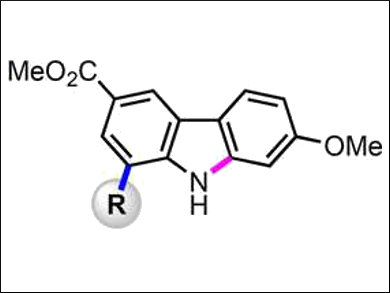Continuous-flow photochemistry is widely used and often offers considerable advantages compared to the corresponding batch processes. Connecting flow processes in sequence can allow for the simple preparation of complex molecules.
Shawn Parisien-Collette and Shawn Collins, Université de Montréal, Canada, have developed a two-step continuous-flow process for the preparation of derivatives of the natural product clausine C, a member of a biologically active family of alkaloids (pictured above). The first reaction is a photo-flow decomposition of a bromo-functionalized azide under a purple light-emitting diode (LED, λ = 394 nm) to give bromo-substituted carbazole derivatives. This is followed by a Pd-catalyzed Suzuki cross-coupling in flow, which gives the desired products. The yields obtained using this continuous two-step method (33–74 %) are equal to or higher than those for the same reactions performed separately under batch conditions.
To further demonstrate the utility of the developed system, the team also investigated a metallo-photoredox coupling reaction as the second step of the process. With a Ni-based catalyst and under blue-LED irradiation (450 nm), a brominated carbazole was coupled with benzyl trifluoroborate in good yield (overall reaction pictured below). According to the researchers, this is the first reported example in which two photochemical flow reactors operating at different irradiation wavelengths have been used in sequence.

- Exploiting Photochemical Processes in Multi-Step Continuous Flow: Derivatization of the Natural Product Clausine C,
Shawn Parisien-Collette, Shawn K. Collins,
ChemPhotoChem 2018.
https://doi.org/10.1002/cptc.201800096



![Synthesis of [c2]Daisy Chains via Mechanochemistry](https://www.chemistryviews.org/wp-content/uploads/2025/04/202504_RotaxanesWithSolidStateMechanochemistry-125x94.png)
